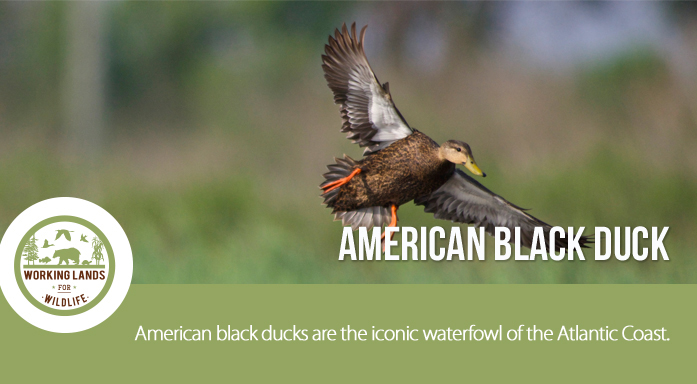The U.S. Department of Agriculture (USDA) has added the American black duck to its premier wildlife conservation effort that helps agricultural producers increase wildlife on working lands. Working Lands for Wildlife (WLFW) is the USDA Natural Resources Conservation Service’s (NRCS) targeted, science-based effort to help restore and protect habitat for declining species on farms and working forests.
The WLFW encourages landowners in targeted areas in Delaware, New Jersey, Maryland, and Virginia to help declining duck populations by restoring tidal and floodplain wetland habitats, non-tidal wetland restoration in cropland and forests, as well as manage healthy riparian areas and streams.
Black ducks thrive in the brackish waters found between salt and fresh waters that have adjacent croplands–sites traditionally found along coastlines. In and along Delaware’s low-lying coastal areas, saltwater intrusion has threatened sustainable production of many crop fields. Funding is now available to landowners or agricultural producers to restore salt marsh habitat with a particular focus on retiring crop production from lands affected by saltwater intrusion and planting salt tolerant species to create ideal habitat for black ducks.
Other practices eligible for funding through this effort include, but are not limited to, shallow wildlife ponds, restoring forested wetlands, and controlling invasive Phragmites to restore salt marsh habitat.
“We are tremendously optimistic about the impact that this effort will have in Delaware—especially in the tidal areas,” said Kasey Taylor, NRCS State Conservationist in Delaware. “This effort will be a platform for our producers to increase habitat for the all-important American black duck while improving conditions on their operations.”
When habitat is restored for the black duck, many other species are likely to benefit including a variety of waterfowl species such as the northern pintail, mallard, teal, other bird species and downstream fisheries. NRCS uses the black duck and other wildlife as indicators of the health of the ecosystem at-large.
NRCS staff worked with several conservation partners to identify priority American black duck focus areas. Partners include Ducks Unlimited, The Nature Conservancy, the National Fish and Wildlife Foundation and state wildlife agencies.
“Ducks Unlimited is excited for this opportunity to work with NRCS and partners to improve American black duck habitat through Working Lands for Wildlife,” said Jake McPherson, Ducks Unlimited Regional Biologist. “This lines up precisely with our commitment to wetland and waterfowl conservation.”
“The Delmarva Peninsula is critical to achieving habitat and water quality goals for the Chesapeake Bay and the key to success will be targeting resources to areas where they will bring the greatest benefit and working collaboratively with private landowners,” said Amy Jacobs, Agriculture Program Director for The Nature Conservancy. “The Nature Conservancy is excited about this NRCS initiative not only for how it will help one of the Bay’s most iconic species, but for how improving black duck habitat will also improve water quality downstream.”
With more than two-thirds of the continental United States under private ownership, wildlife depends heavily on working lands for habitat and food. WLFW projects focus on declining species that have needs compatible with agricultural practices and rural land management. Click here to see a full list of new projects.
Financial and technical assistance are available through NRCS to restore habitat for American black duck on agricultural lands. To learn more, please visit your local USDA service center. In Delaware’s Sussex County, call 302-856-3990 ext. 3; in Kent County, call 302-741-2600 ext. 3; and in New Castle County, call 302-832-3100 ext. 3

